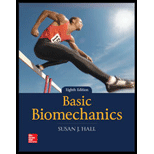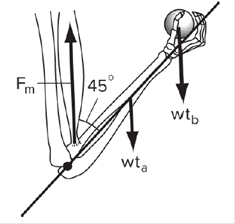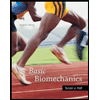
Concept explainers
A 35-N hand and forearm are held at a 45° angle to the vertically oriented humerus. The CG of the forearm and hand is located at a distance of 15 cm from the joint center at the elbow, and the elbow flexor muscles attach at an average distance of 3 cm from the joint center. (Assume that the muscles attach at an angle of 45° to the bones.)
a. How much force must be exerted by the forearm flexors to maintain this position?
b. How much force must the forearm flexors exert if a 50-N weight is held in the hand at a distance along the arm of 25 cm? (Answers: a. 175 N; b. 591.7 N)

a)
To determine: The force exerted by the forearm.
Answer to Problem 3AP
The force exerted by the forearm is
Explanation of Solution
Calculation:
Consider torque acts on the counter clockwise direction for forearm of the hand will be taken as positive and the torque acts on the clockwise direction for joint center of the elbow will be taken as negative.
Express the magnitude of the net torque acts on the joints.
Here,
Rewrite the equation (I) for the net forces acts on the joints of the hand.
Here,
Substitute
Therefore, the force exerted by the forearm is
b)
To determine: The force on the forearm flexors exerts on the weight hold in the hand.
Answer to Problem 3AP
The force on the forearm flexors exerts on the weight hold in the hand is
Explanation of Solution
Calculation:
Rewrite the equation (I) for the net forces acts on the weight holds in the hand.
Here,
Substitute
Solve the relation for
Therefore, the force on the forearm flexors exerts on the weight hold in the hand is
Want to see more full solutions like this?
Chapter 13 Solutions
BASIC BIOMECHANICS
- Maximal muscle force changes continuously throughout the elbow flexion according to the joint angle. True Falsearrow_forwardA patient is completing a knee extension exercise. The patellar tendon inserts on the tibia 2.92 cm away from the knee joint axis of rotation. The foot is 40.38 cm away from the knee joint axis of rotation. What is the foots arc length through the exercise if the patellar tendon insertion moves through an arc length of 7.80 cm? Report you answer in meters.arrow_forwardThink of two functional activities that can improve the strength of flexor digitorum superficialis / flexor digitorum profundus. Provide a short description and justificationarrow_forward
- An isometric exercise is one in which the joint angle does not change during the application of muscle force. For instance, you can join your hands together, pushing down with one hand and pushing up with the other. In each arm, the muscles that provide the force are connected to the bones of the arm by tendons. If you increase the forces but keep the angles the same, the muscles will still contract. Explain how this is possible.arrow_forwardTo do Left hip extension in the Sagittal plane, the (name the muscle) would have to lie (A –rWhere?) relative to the joint, and since it can only (PULL ), the fibers would have to run (PERPENDICULAR) to the (D ) axis to achieve the desired movement. choose from: A. Pick from: Anterior, Posterior, Medial, Lateral, Superior, Inferior B. Write in the word “PULL” C. Write “perpendicular” D. Pick from :Anterior - posterior, Superior-inferior or Medio - Lateralarrow_forwardA. How is the knee musculature acting from B to C? B. What muscles are acting knee joint from A to B? C. What motion is occurring at the pelvis from A to B? D. What classification of lever is being demonstrated with this exercise? E. Where is the location of the force application? F. What plane of motion is this exercise occurring in? G. What position is demonstrated at the talocrural joint in frame B?arrow_forward
- Look at the elbow joint x-ray. Why is 90° the optimal joint angle for biceps activation? What would happen during flexion/extension? Explain in detail !arrow_forwardIf an individual does training with only the right knee extensor muscles, it is common to see increase in strength in knee extension force for the right leg and an increase in strength in the knee extension force of the left leg (although the increase in force is typically not to the same extent as the force increase in the right leg) a.) True b.) Falsearrow_forwardDescribe the qualities of the muscle fiber arrangement and tendon attachments of biceps femoris. Discuss synergist(s) and antagonist(s) muscles and their attachment sites of biceps femoris. Describe when synergists and antagonists contract compared to the biceps femoris.arrow_forward
- During a Physical Education class, you ask your students to perform a standing vertical jump. Identify the type of muscle contraction involved in the jump and describe the movement patterns of the concentric and eccentric phases. Outline the agonists, antagonists and synergist muscles, which contribute to maximum jump height. Identify the major lower body joints and joint movements, which contribute to the concentric phase of the jump.arrow_forwardWhat implications does this all have on the ability to perform curls and pull-ups using "overhand" (pronated) vs. underhand" (supinated) hand positions? O Easier to do in the supinated position because the biceps brachi loses mechanical advantage in the pronated position O Easier to do in the pronated position because the biceps brachil muscle loses mechanical advantage in the pronated position O Easier to do in the supinated position because the brachialis muscle loses mechanical advantage in the pronated position O Easier to do in the pronated position because the brachialis muscle loses mechanical advantage in the supinated positionarrow_forwardList all six possible movements that can occur at the shoulder joint and name the prime mover(s) of each movement. Then name their antagonists.arrow_forward

 Basic BiomechanicsBioengineeringISBN:9780073522760Author:Susan J HallPublisher:McGraw-Hill Education
Basic BiomechanicsBioengineeringISBN:9780073522760Author:Susan J HallPublisher:McGraw-Hill Education

